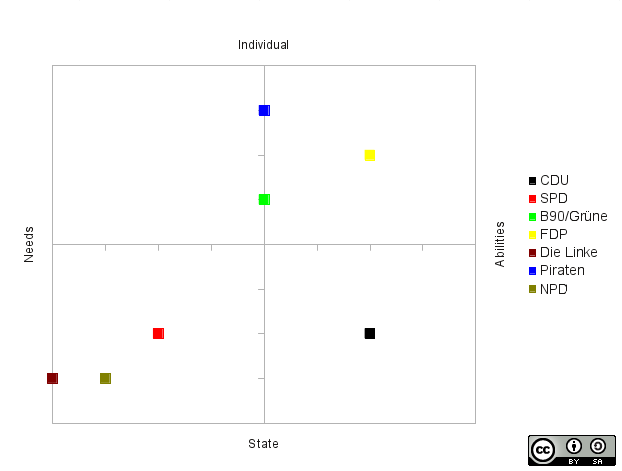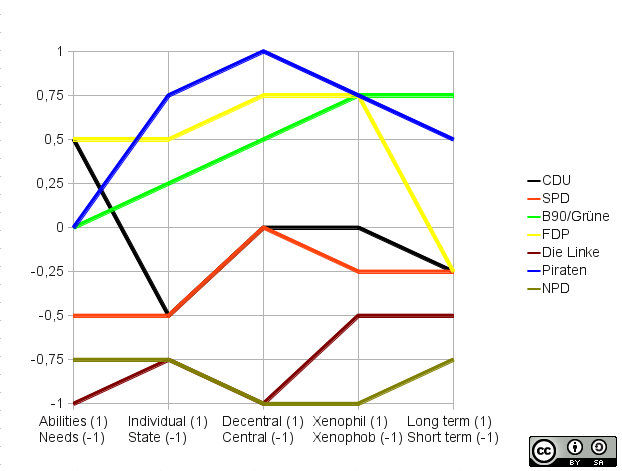The traditional “left – right” scheme is not sufficient.
In order to reflect political positions more accurately, I devised a two dimensional scheme. Through many discussions and arguments with friends and colleagues, it matured over time. The results are explained in the following diagram:
(added 2011-01-15)


Instead of a single dimension from left to right, this scheme uses the two dimensions:
- The balance between needs and abilities
- The balance between state and the individual
With this diagram I want to stimulate a discussion about the placement of different parties or other organisation. I positioned the major German parties based on my intuitive estimate. For reference I included the two leading US parties as well. I do not claim that this is a correct or final expression of the current situation.
I would be very happy to see a healthy discussion around this proposal and if you want to contribute, just write a quick comment. You can also use the editable SVG file (linked below the diagram) to visualise your own ideas.
Greetings
Tim
Updates based on the comments below:
(2011-01-15)
Let me clarify the two original dimensions:
- Needs and abilities is based on the question
“What a person deserves is based on what the person needs. Or: It is based on what the person can achieve with its abilities.”. - State and individual is based on the question
“Can each person apply its own solution to a subjective issue or does the state collectively define issues and solutions?”
Regarding the reappearing question of additional dimensions: In my first thoughts I included more dimensions, but dropped most of them in favour of making it easier to grasp and printable. In order to accommodate more dimensions on a two dimensional presentation, I added a parallel coordinates plot above which additionally includes the dimensions:
- Balance of centralisation and decentralisation
“Should a solution be implemented on the lowest possible level (subsidiarity) or should a central government implement global solutions?” - Balance of xenophobia and xenophilia
A xenophile statement would be: “It doesn’t matter where somebody is from as long as he pays his taxes.”. A xenophob statement is: “National workers first!” - Long term and short term orientation
This is closely related to sustainability; Does a party focus on short term gains or does it take future effects into account? What is the time frame a party uses to evaluate their decisions? Just a few months or a couple of generations?
According to Melly’s comment, I positioned the green party a bit closer to the centre on the needs/abilities axis to reflect the even balance. Based on Nightwolf’s comment, I added the German Pirates Party.
Especially regarding the pirates, there is still a high level of uncertainty, but I guess their future tendency will be more towards the state and the needs. This highlights another aspect, currently neglected by the diagrams: uncertainty distributions. As hardly anything in life is 100% certain, especially not in politics, each rating in each dimension should also define the type and the spread of the uncertainty distribution.
As the information density rises with more dimensions and even uncertainty distributions added, I would welcome creative ideas on how to visualise both in a single diagram.
(2011-03-03)
Wikipedia before you think? 😀 Certainly not!
http://en.wikipedia.org/wiki/Political_spectrum


You guess you already know the Political Compass? http://www.politicalcompass.org/
I’m missing the Pirate Party in your diagram (and what does “D” and “GOP” stand for?).
The problem with the diagram is in my opinion that it gives no information what ideas a party has for fulfilling needs and so on. It’s really too simple.
Hi Nighwolf,
Political Compass is interesting, but I think their dimensions are a bit messy, still sticking to the old left/right scheme. The description libertarian(ism) even appears on both dimensions.
Regarding your second point, I have to agree. Of course it is too simple to accurately represent all aspects of politics, but I think it is a lot more useful then simply left and right.
As the Piraten Partei still is not entirely clear about their direction, I would position it in a broad band between needs and abilities on the far side towards the individual. The tendency seems to be towards the needs, though.
Cheers
Tim
PS: (D)emocrats and (G)rand (O)ld (P)arty, the Republicans
Hi Tim,
I agree with Nightwolf that this diagram neglects information concerning the individual programs of those parties. Your scheme doesn’t refer clearly to all the other factors like economy, environment, society, laws etc. which can’t be combined just in categories like “state” or “individual” especially today in a world where we can’t see our political systems isolated and those factors have become global issues. Placing the Green party for example on the side of needs without seeing the abilities is too one-dimensional. They often go hand-in-hand, especially looking on long-term effects. If you take sustainable energies, something that the Green party stands for example, you can find needs (clean environment, safety, climate friendliness) but also abilities for the economic future (independence of traditional resources, affordability in the long-term-effect also for poor countries which means stability and peace, cheaper in the future, new abilities in technical possibilities…).
Besides that, I also agree concerning the Pirate party. They extended their program in society and environmental topics and are not just only a data protection party anymore. Besides that they also exist in other countries.
BUT: I definitely like the squirrel on the page!!! 🙂
Hey Tim,
you have done a lot of work and thinking doing these diagrams: respect!!! 🙂
In my opinion it is still hard to put parties in those diagrams under the claim of doing a correct allocation because such a judgement is still pretty much subjective. I guess many people with different point of views and different opinions would do different allocations. For example in my point of view the German liberals (FDP) as they are right now are not xenophile. They are very critical about people from another cultural background who want to live and work here. And what makes you think that the NPD party has even just a teeny tiny bit of long-term thinking? In my opinion that value has to be -5 or so…See? It’s all about the personal point of view and besides that it’s very much about which politicians do the current politics of those parties. The FDP for example was different when they still had Genscher…
Hi Melly,
I fully agree regarding the subjectiveness and in some places the uncertainty of my rating.
I think a collaborative rating system could be very interesting here, maybe K can help?
For each dimension, a web interface could ask visitors to arrange the parties in the order they perceive as correct. Based on this bigger data set, statistical information, like the spread of a parties rating, could be derived. Such a system could even visualise the development over time!
As usual, there’s still a lot to do …
Greetings
…but, to admit, I have no other idea to visualize the parties in such diagrams. In my opinion it’s just not possible to do so because even when analyzing all those partie’s programmes very thoroughly there’s still personal interpretation when giving them a special value in the diagrams. Maybe, if you would involve many people in doing this you could at least get an average value how people judge the parties. But then it also depends which people from which area and background you choose…
..ah yeah, you already said the same 🙂
Well, it’s hard to say, because even if you do so, you just get a current status of people’s opinions.
Nighty-night 😉